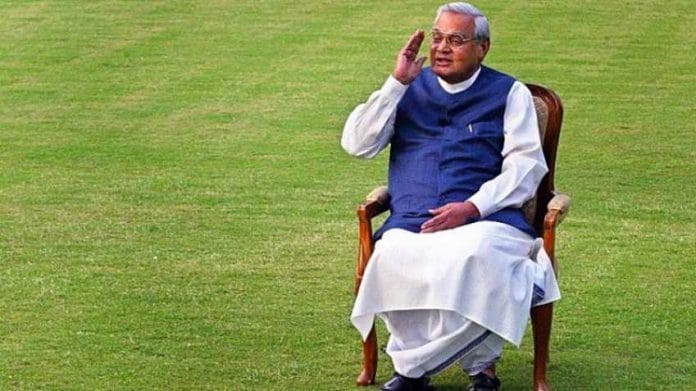He was no secularist, neither was he a bigot who endorsed violence.
An old video of Atal Bihari Vajpayee speaking on the Babri Masjid-Ram Janmabhoomi issue is among the pieces of evidence that is brought out to show he was no moderate.
Yet, Vajpayee also condemned the demolition immediately after it happened. This is why he was often called the mukhauta, the moderate mask of an extremist force.
The Hindu right often tries to paint the entire left-of-centre spectrum with the same brush. From Gandhians to Maoists, anyone who opposes Hindutva is the same for them.
But similarly, left-liberals make the mistake of painting the entire right-wing with the same brush. In failing to observe the shades of saffron, they do themselves a disservice because it comes in the way of understanding the complexity of politics and society.
Also read: Vajpayee was popular even among citizens who didn’t vote for him, writes his PMO aide
The rise of Narendra Modi today makes L.K. Advani look more moderate by comparison, especially since Advani tried to use Jinnah and Pakistan to change his image (and failed miserably). To remember Vajpayee in the Modi-era is to recognise the shades of saffron.
Vajpayee was saffron no doubt. He was a swayamsewak, and rose through the ranks. From Ram Mandir to Article 370 to uniform civil code – he shared all the ideas and objectives of the BJP and the RSS. And yet, he was also perennially at loggerheads with the RSS, which felt Vajpayee wasn’t giving it enough fruits of power. He walked a tightrope, making himself the sea where rivers of contradiction merged.
Vajpayee rose above many prime ministers because he was a reconciler, as some would argue any prime minister should be. He managed the impossible task of bringing ideologically disparate parties together and, after much effort, provided a stable government in the coalition era. At one point, he led a coalition of 24 parties.
He said on the floor of the House that he wasn’t pursuing the Hindutva agenda of Ram Mandir, Article 370 or uniform civil code because his party didn’t have the mandate to do so. “There is nothing to hide in this,” he said. So, it wasn’t a fake moderation but an honest pragmatism. He was no secularist – he didn’t claim to be one.
In pursuit of power, he blunted the extremist edge of Hindutva. Yet, this was also a pursuit of an evasive national reconciliation. Vajpayee’s moderation made it possible for even those opposed to Hindutva to work with the BJP. This wouldn’t have been possible with Advani at the helm, and Advani stepped aside for Vajpayee because he knew this.
Such moderation and reconciliation could be cynically brushed away as mere means to pursue power or, worse, as normalising Hindutva. But these are also values a nation needs when it cannot come up with a national consensus. And in those days, with one unstable coalition after another, India was looking for a consensus. Vajpayee was the figure who managed to bring about consensus, and thus earned himself a place in history and monikers like statesman.
Also read: Atal Bihari Vajpayee: Poet-politician and one of India’s most charismatic leaders
This is why the Congress party could not oppose the Modi government’s decision to give Bharat Ratna to Vajpayee in 2014. But the Congress and the opponents of Hindutva had a face-saver at hand. They were able to recall Vajpayee’s advice to Modi to respect “rajdharma” after the 2002 Gujarat violence.
It will be an exaggeration to compare Vajpayee to Nehru, but there’s little doubt that Nehru had left an imprint on Vajpayee’s mind. At least for his own party, the BJP, Vajpayee was a Nehru-esque father figure who brought it to power, just as Modi is more like Indira Gandhi, a hardline leader.
Vajpayee was a reconciler in other ways as well. He pursued peace with Pakistan with a seriousness not seen for years before or after him. If he made the hardline in the RSS unhappy with his moderation, he also took to working on the nationalist pride by displaying his leadership in the Kargil War and going ahead with the nuclear tests.
He is the only prime minister in living memory who managed to convince the Muslim-dominated Kashmir that he was serious about peace and conflict resolution. These are things considered impossible even today. Modi with a full majority is unable to do them. Having only heightened the alienation in Kashmir, Modi is forced to say these days that he will follow Vajpayee’s path in the Valley.
It is easy to hail Vajpayee as a moderate or dismiss him as a mukhauta. The real Vajpayee was the reconciler who put things together, made things happen, and brought India out of the sense of stagnation that unstable coalitions had left it with.
India will always be a land of contradictions and differences, of unmanageable extremes. It will always need a Vajpayee within every ideology and in every party.
Also read: How Vajpayee worked with leaders from rival parties to save the Sukhoi-30 deal in ’96







To the extent one can judge a reclusive figure like Vajpayeeji, I don’t think his heart would have been in something as divisive as the abrogation of Article 370. He understood in his heart – and the acme of his career as PM between 1998 and 2004 bears witness to this – that some of his party’s core beliefs / dogma simply would not resonate in large parts of the country, among large swathes of the population. He would not have wished to stand on their head these foundational values, content simply to downplay them sufficiently to make a success of both his governing coalition and his practice of governance. He did not require a tutorial to understand that 282 is not 543; 31% is certainly not 100%.